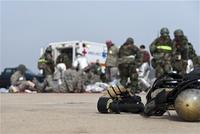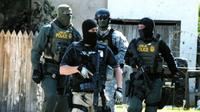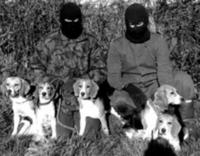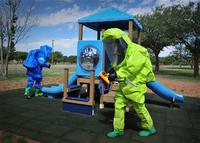-
Firefighting robot creates 3D images of burning buildings’ interiors for rescuers
Researchers develop novel robotic scouts that can help firefighters to assist in residential and commercial blazes. The robots will map and photograph the interior of burning buildings by using stereo vision. Working together both collaboratively and autonomously, a number of such vehicles would quickly develop an accurate augmented virtual reality picture of the building interior. They would then provide it in near real time to rescuers, who could better assess the structure and plan their firefighting and rescue activities.
-
-
U.S. military trains to support civil authorities during domestic CBRN incident

Vibrant Response 13-2 exercise, conducted by U.S. Northern Command and led by U.S. Army North (Fifth Army), is an annual event and is the country’s largest CBRN exercise. The training exercise is used to evaluate a military unit’s operational and tactical ability to support civil authorities during domestic incidents involving chemical, biological, radiological, or nuclear weapons.
-
-
DEA uses NSA surveillance information to make arrests

The Drug Enforcement Administration (DEA) has benefitted from multiple tips from the National Security Administration’s (NSA) surveillance programs – although not necessarily the programs revealed by Edward Snowden. DEA officials in a secret office known as the Special Operations Division (SOD) are assigned to handle incoming tips from the NSA. The information exchanged between the two agencies includes intelligence intercepts, wiretaps, informants, and a massive database of telephone records.
-
-
The FBI uses hackers’ methods in its surveillance programs
The U.S. government is planning to expand its suspect surveillance programs to include tactics which are commonly used by computer hackers.The FBI typically uses hacking in cases involving organized crime, child pornography, or counterterrorism, a former U.S. official said. The agency is less inclined to use these tools when investigating hackers, out of fear the suspect will discover and publicize the technique.
-
-
Interpol issues global alert following nine al Qaeda-linked prison breakouts
Interpol, in a statement issued from the organization’s headquarters in Lyon, France, urged law enforcement agencies around the world to show “increased vigilance,” following prison breakouts over the past nine month in nine countries, including Iraq (22 July), Libya (27 July), and Pakistan (31 July). More than 2,500 terrorists have escaped in these nine prison breakouts.
-
-
FBI terrorism unit investigates animal rights group after pheasant farm attack

An FBI Joint Terrorism Task Force has launched an investigating after an animal rights group announced on its Web site that its members cut open fencing around a and releasing more than a dozen pheasants from the aviary at Ash Grove Pheasant Farm and Orchard in Riverside, California. The incident took place 22 July.
-
-
Locating criminals by tracking their cell phones’ digital fingerprints
To keep from being tracked and getting caught, criminals use evasion tactics such as modifying the built-in ID code in their cell phone or swapping out SIM cards, making it impossible for law enforcement to track the criminals down by relying solely on cell phone signals. German engineers found, however, that the radio hardware in a cellphone — a collection of components like power amplifiers, oscillators, and signal mixers — all introduce radio signal inaccuracies. When these inaccuracies, or errors, are taken together, as seen in the digital signal sent to a cell tower, the result can be read as a unique digital signal –a digital fingerprint. These digital fingerprints do not change even if the built-in ID code has been modified, or the SIM card has been swapped out.
-
-
Largest annual homeland security exercise to star Monday in Indiana
DHS will be conducting its largest training event of the year next week in Butlerville, Indiana. The event will involve 5,500 people from twenty-three states, and will start next Monday.
-
-
U.S. Appeals Court: govt. does not need search warrant to track cellphones

Law enforcement agencies have won a victory Tuesday when a federal appeals court ruled that government authorities could extract historical location data directly from telecommunications carriers without a search warrant. The ruling by the U.S. Court of Appeals for the Fifth Circuit is the first ruling directly to address the constitutionality of warrantless searches of historical location data stored by cellphone service providers. He appeals court said that historical location data is a business record which is the property of the cellphone provider. The appeals court also said that the collection of such data by authorities does not have to meet a probable cause standard as outlined under the Fourth Amendment, which protects against unlawful search and seizure and requires a search warrant.
-
-
Quake Summit 2013: showcasing research on earthquakes, tsunamis
Members of a national earthquake simulation research network next week will gather at the University of Nevada, Reno (UNR), for Quake Summit 2013, a scientific meeting highlighting research on mitigating the impact of devastating earthquakes and tsunamis. Titled “Earthquake & Multi-Hazards Resilience: Progress and Challenges,” the annual summit of the 14-site George E. Brown Network for Earthquake Engineering Simulation (NEES), will run from 6 August through 8 August at UNR’s Joseph Crowley Student Center.
-
-
Online tools accelerate progress in earthquake engineering, science
A new study has found that on-line tools, access to experimental data, and other services provided through “cyberinfrastructure” are helping to accelerate progress in earthquake engineering and science. The cyberinfrastructure includes a centrally maintained, Web-based science gateway called NEEShub, which houses experimental results and makes them available for reuse by researchers, practitioners, and educational communities. NEEShub contains more than 1.6 million project files stored in more than 398,000 project directories and has been shown to have at least 65,000 users over the past year.
-
-
Simulations help in studying earthquake dampers for structures
Researchers have demonstrated the reliability and efficiency of “real-time hybrid simulation” for testing a type of powerful damping system that might be installed in buildings and bridges to reduce structural damage and injuries during earthquakes. The magnetorheological-fluid dampers are shock-absorbing devices containing a liquid that becomes far more viscous when a magnetic field is applied.
-
-
Hazmat Challenge tests skills of hazmat response teams from three states

Twelve hazardous materials response teams from New Mexico, Missouri, and Oklahoma will test their skills at the 17th annual Hazmat Challenge, which will be held 30 July through 2 August at Los Alamos National Laboratory.
-
-
The arithmetic of gun control and gun violence
The most comprehensive statistical study of gun violence in the United States – examining data going back to the First World War – finds that, in more common domestic and one-on-one crimes, reduced legal gun availability, if properly enforced, is likelier to lower deaths. In rare mass shootings, armed citizens might save lives if sufficiently trained to avoid accidentally shooting fleeing bystanders. The authors note, though, that key parts of their equations should be studied more closely: the fraction of offenders who illegally possess a gun, the statistical degree of protection provided by legal gun ownership, and the number of people who are legally carrying a gun when attacked. Comprehensive data in those areas, they say, could further aid the development and implementation of effective policies.
-
-
Research priorities for understanding public health aspects of gun-related violence
A new report from the Institute of Medicine (IOM) and National Research Council (NRC) proposes priorities for a research agenda to improve understanding of the public health aspects of gun-related violence. The committee which wrote the report said significant progress can be achieved in three to five years through a research program that addresses five high-priority areas: the characteristics of gun violence, risk and protective factors, prevention and other interventions, gun safety technology, and the influence of video games and other media.
-
More headlines
The long view
Tantalizing Method to Study Cyberdeterrence
Tantalus is unlike most war games because it is experimental instead of experiential — the immersive game differs by overlapping scientific rigor and quantitative assessment methods with the experimental sciences, and experimental war gaming provides insightful data for real-world cyberattacks.
Using Drone Swarms to Fight Forest Fires
Forest fires are becoming increasingly catastrophic across the world, accelerated by climate change. Researchers are using multiple swarms of drones to tackle natural disasters like forest fires.
Testing Cutting-Edge Counter-Drone Technology
Drones have many positive applications, bad actors can use them for nefarious purposes. Two recent field demonstrations brought government, academia, and industry together to evaluate innovative counter-unmanned aircraft systems.
European Arms Imports Nearly Double, U.S. and French Exports Rise, and Russian Exports Fall Sharply
States in Europe almost doubled their imports of major arms (+94 per cent) between 2014–18 and 2019–23. The United States increased its arms exports by 17 per cent between 2014–18 and 2019–23, while Russia’s arms exports halved. Russia was for the first time the third largest arms exporter, falling just behind France.
How Climate Change Will Affect Conflict and U.S. Military Operations
“People talk about climate change as a threat multiplier,” said Karen Sudkamp, an associate director of the Infrastructure, Immigration, and Security Operations Program within the RAND Homeland Security Research Division. “But at what point do we need to start talking about the threat multiplier actually becoming a significant threat all its own?”
The Tech Apocalypse Panic is Driven by AI Boosters, Military Tacticians, and Movies
From popular films like a War Games or The Terminator to a U.S. State Department-commissioned report on the security risk of weaponized AI, there has been a tremendous amount of hand wringing and nervousness about how so-called artificial intelligence might end up destroying the world. There is one easy way to avoid a lot of this and prevent a self-inflicted doomsday: don’t give computers the capability to launch devastating weapons.
